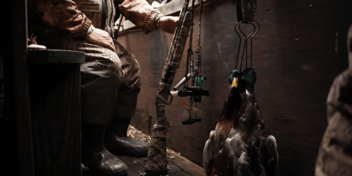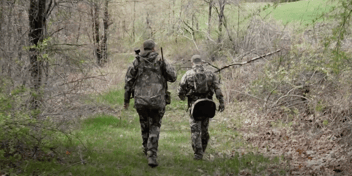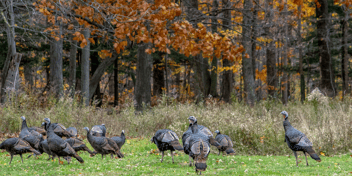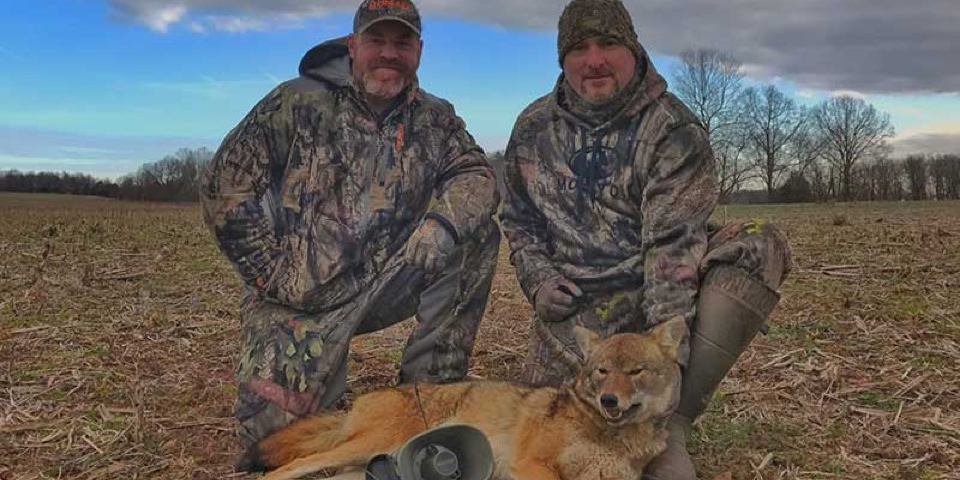
When I stepped out on the front porch of my house one recent Saturday morning, I knew right away the wind was going to give us fits when it came to calling predators. I started to call my buddy, Scott, and tell him that we’d try another time, but I knew he was just as eager to get out as I was. So I slipped into my boots, loaded my gear in the truck, and headed down the road hoping to beat the wind and call in a hungry predator.
Our first set of the morning was a bust. The wind was carrying our scent right into a block of woods I was hoping to call into. We backed out and made plans for a return visit. On our way to the second set, I pulled up the weather app on my iPhone. The wind had already bit me once, I didn’t want to see it happen again. The app showed a solid crosswind for the next two calling sets.
Stand number two found us calling around an old barn on the edge of a field. The old barn was surrounded by dozer piles and thick cover. I figured it would be the perfect site to call up a bobcat or fox, so we played prey sounds rather than coyote vocals. The wind intensified as we rolled through our second calling sequence, and I whispered to Scott, “We’re gonna have to be right on them for them to ever hear us today.”
When nothing showed on the second set, I mentioned to Scott that we should move a short distance and sit back down to try it again. I was confident the area held a predator or two, and I was pretty sure the wind was keeping our sound from reaching where it needed to be. So we moved just 200 yards around the edge of the field and set back up. The wind was now in our face rather than at our back, but it was still holding perfect for a crosswind approach from any predator.
Beat the wind and you'll have predators close enough to kill with a shotgun. And the Mossberg 930 with Pistol Grip is hard to beat on hard-charging predators.
We continued to play the Eastern Cotton sound on our FoxPro caller. I had set the caller and a Mojo Critter decoy far enough into the field that it left ample room for a coyote’s downwind approach. If everything went according to the script our target would approach from our left. When he circled downwind of the decoy and caller, he’d be right in our lap.
Two minutes into the calling stand I looked up and saw a coyote bust out of the timber charging hard to the decoy. The big female charged straight up to the call before going into sneak-mode just a few yards from the decoy. When she stepped to the downwind side of the decoy, Scott barked to stop her. Instead of stopping, she turned around and began a hasty retreat. She looked back over her shoulder one last time before Scott rolled her up at 50 yards.
The rewards of beating the wind are sweet. The author (left) and friend, Scott Braham, with the coyote that came to the call on a very windy day.
It was a classic example of how to beat the wind, even in the toughest conditions, to get the job done when calling predators.
Here are 3 steps I rely on when it comes to beating the wind to kill more coyotes.
1. Place an Electronic Caller Upwind of Your Stand Set
The single greatest selling point for me when I dove into the world of electronic calls was the fact that I could place the sound where I wanted it. No longer did I have to worry about a coyote pinpointing my stand location. With an eCaller, their focus and attention can easily be moved to wherever you desire. And 95% of the time that will be upwind. It’s in a coyote’s nature to circle downwind of their dinner as they move in for the kill. The eCaller allows you to make that downwind approach happen right in your lap. It’s genius!
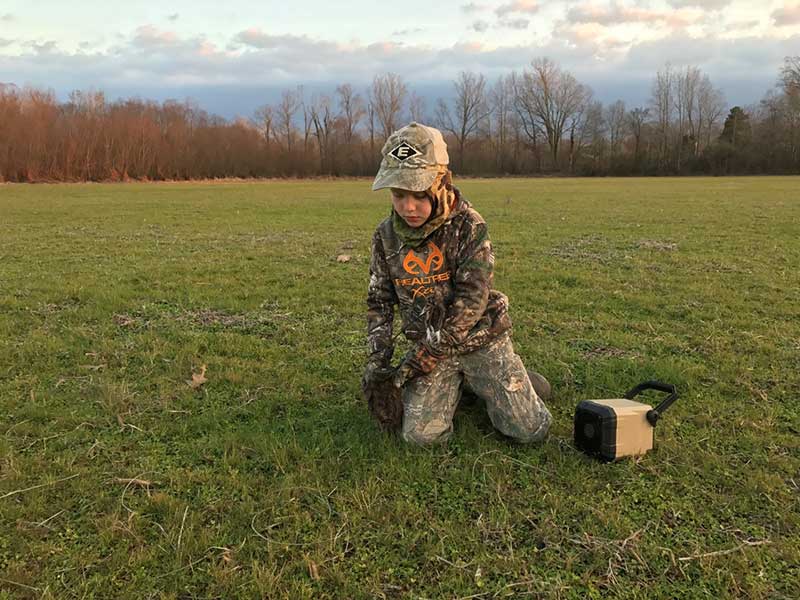
Set your eCaller and decoy upwind of your calling stand and you'll likely have a coyote circle right into your lap as they make their downwind approach.
The distance to place your call will vary depending on the wind, landscape, and visibility, but I typically place the call 40-50 yards from my calling stand. I’ll move it in closer if I’m hunting strictly with a shotgun or with my bow. The key is to draw that coyote’s attention away from you. The caller and decoy set away from you will help create the ultimate ambush. They’ll have no idea you’re in the world.
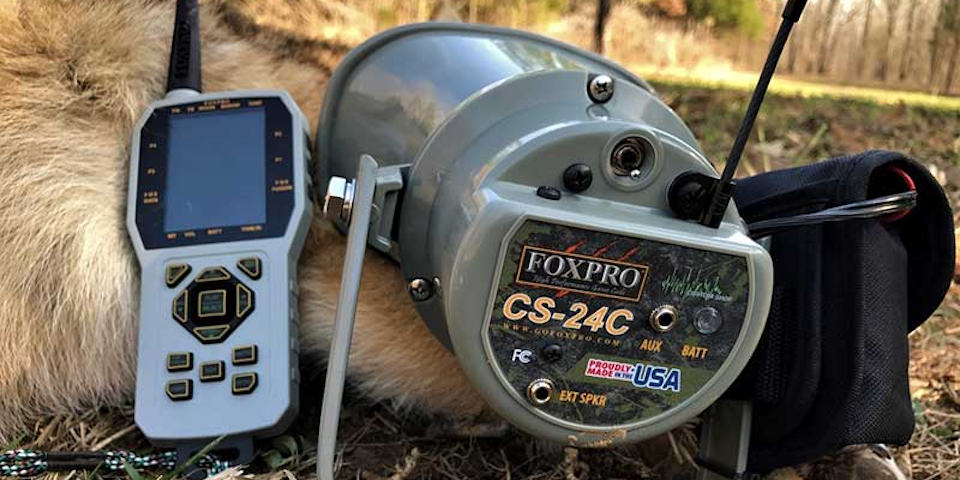
A good eCaller with plenty of sound amplification to cut the wind is a must. The FoxPro CS-24C does an excellent job at broadcasting sound even on the windiest days.
2. Leave Downwind or Crosswind Access for Approach
On the hunt mentioned above, I almost pushed my luck too far. Because of the wind blowing so hard, and my desire to cast the sound as deep into the woods as possible, I debated moving further around the edge of the field. The wind would have been decent for the set, but it wouldn’t have allowed any room for a coyote’s approach in the field. With wind direction in mind, make your calling sets in such a way that the coyote has ample downwind approach opportunities that are in the open. If the coyote remains in the woods as it circles downwind of your setup, you’ll be busted, and probably never even know you had a coyote responding to your call. Make sure there is some downwind acreage for a responding predator to circle downwind in the field.
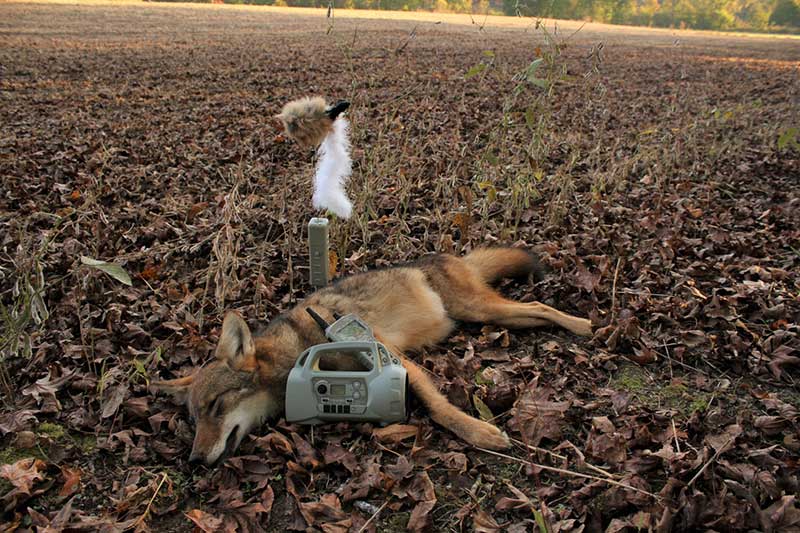
Leaving ample room along the edge of this field gave just enough room for this coyote to slip in for a downwind approach to the decoy and eCaller.
3. Live By the Wind/Weather Forecast When Planning and Executing Stand Locations
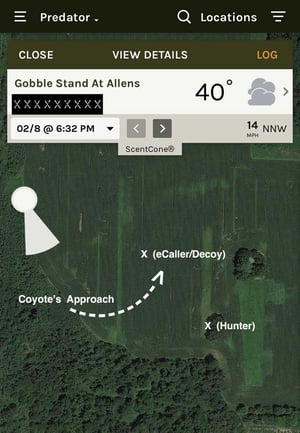 Changing weather, particularly the wind, can be a deal-breaker when it comes to calling predators. You’ve seen it happen a thousand times before. You check the weather, and the wind is blowing perfect for the stand you’re planning to hunt. However, when you get to the stand you find that the wind is now blowing in a completely different direction than what it was an hour ago.
Changing weather, particularly the wind, can be a deal-breaker when it comes to calling predators. You’ve seen it happen a thousand times before. You check the weather, and the wind is blowing perfect for the stand you’re planning to hunt. However, when you get to the stand you find that the wind is now blowing in a completely different direction than what it was an hour ago.
I rely on the ScoutLook weather app to keep me posted on the weather will be doing. It's very accurate. The ScoutLook app helps you beat the odds when it comes to changing wind conditions with their ScentCone feature. The ScentCone tells you what the wind is doing, as well as how it might shift on an hourly basis in the future. It’s a feature that’s worth its weight in gold.
This image shows the ScoutLook ScentCone wind direction, eCaller location, hunter location, and how the coyote approached. It was a textbook ambush.
The app allows you to store all your stand site locations, notes, and ideal wind directions. So when I’m planning a hunt, I simply pull up my predator hunting locations in ScoutLook, check what the ScentCone is currently showing for wind, and then scroll through the hourly forecast to see how/if the ScentCone changes. It’s the perfect tool to prevent wasted time and blown hunts due to poor wind direction.
So if you want to kill more coyotes this year, learn to beat the wind. By placing an electronic caller upwind, setting up with ample space for a coyote’s downwind approach, and using the ScoutLook app religiously, you’ll be well on your way to more fur in the back of the truck.
About the Author


